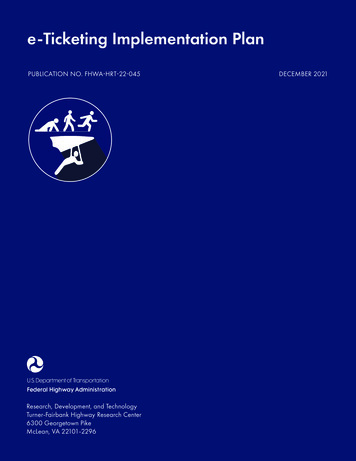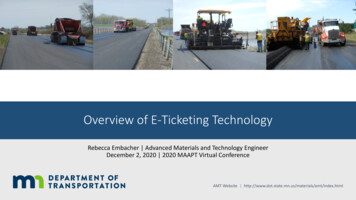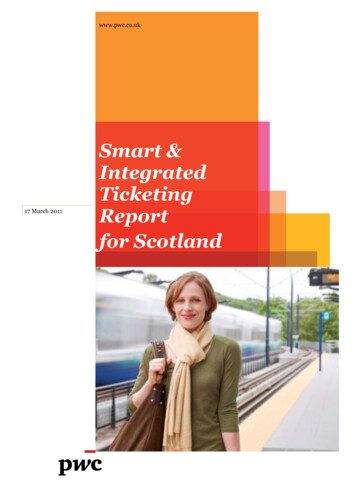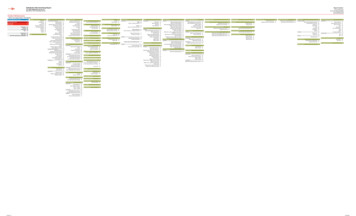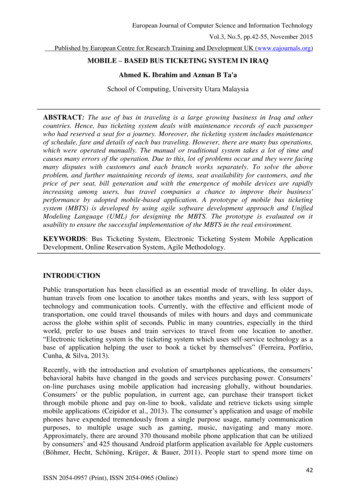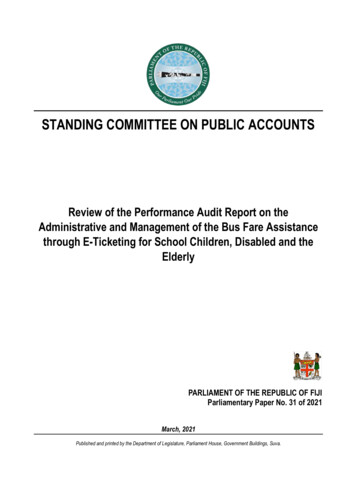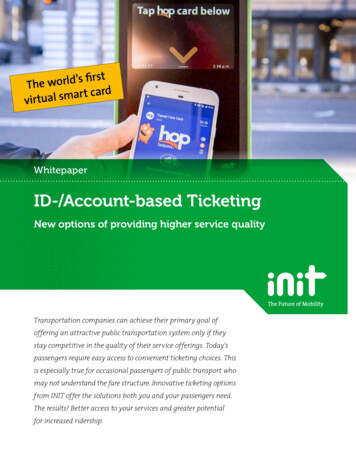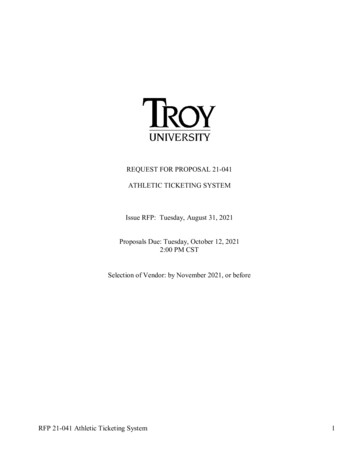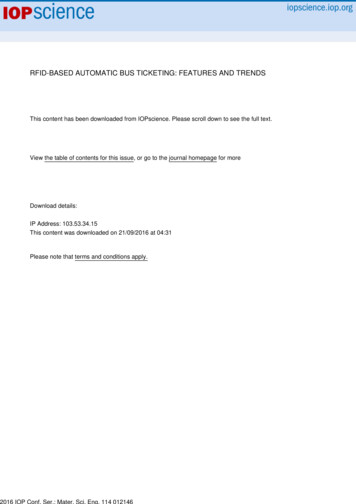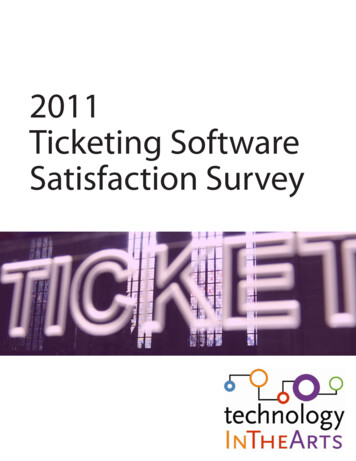
Transcription
2011Ticketing SoftwareSatisfaction SurveyTicketing Software Satisfaction SurveyMarch 2010
Technology in the Arts www.technologyinthearts.orgTechnology in the Arts explores the intersection of arts management and technology to sparkdialogue around the role of technology in our planning and programming, share best practices,and provide training in the use of online tools. Our services include consulting, professionaldevelopment training, webinars, an online resource directory, monthly podcasts, and adiscussion-based blog.Center for Arts Management and Technology camt.artsnet.orgTechnology in the Arts is a series of services from the Center for Arts Management andTechnology (CAMT), an applied research center at Carnegie Mellon University exploring waysin which arts managers can employ online technologies to more effectively meet theirorganizational goals and engage audiences.2011This work is licensed under the Creative Commons Attribution-No Derivative Works 3.0 UnitedStates License by Carnegie Mellon University’s Center for Arts Management Technology.Thanks!CAMT would like to give special thanks to Amelia Northrup, David Dombrosky, Pat Germann,Tiffany Wilhelm, and Shryansh Mehta for their efforts in preparing this report.Cover photo credit:Gyorgy Kovacs via flickr 599/)22011 Ticketing Software Satisfaction Survey
ContentsIntroduction.4Overview of Results.5Results by Budget Size Category:Small Organizations.12Mid-sized Organizations.18Large Organizations.24Very Large Organizations.30Choosing a Ticketing System.36Appendix:List of systems included in the survey.4132011 Ticketing Software Satisfaction Survey
IntroductionAbout this surveyThe variety of ticketing software solutions on the market today encompasses a tremendousrange of capabilities, features, and price points. As a service to the arts and culture field, wecreated this survey to learn about organizational needs and to gauge how well current ticketingtools are meeting those needs.In designing this survey, we thought the following information would be useful for other arts andcultural organizations seeking a ticketing solution: which attributes do arts organizations consider critical in a ticketing toolwhich factors influence organizations’ ticketing software choiceswhich tools are arts and cultural organizations usinghow satisfied are arts and culture organizations with their current ticketing solutionsOver 1,000 people started the survey, and a total of 957 evaluated at least one ticketing tool.The survey included 86 software tools as well as an “other” option for evaluating tools not on thelist. A complete list of programs included in this survey can be found at the end of this reportand online at http://bit.ly/2011ticketing.To distribute the survey, we approached arts service organizations, arts councils, ticketingassociations, and software vendors to share the survey with their members and clients. Wefound that the number of respondents evaluating a particular tool depended largely uponwhether or not that vendor participated in the survey distribution. For this reason, thepercentage of respondents using a particular tool cannot be construed as actual market share.We changed a few questions this year, based on feedback from the 2009 survey. We also soughtthe opinions of vendors and arts service organizations on how the survey questions could beimproved. Changes include: Added features regarding new technologies, like mobile and social media integration Added questions differentiating web-based vs. desktop software (hosted on the client’scomputer or server) Added question about ticket consortiums and outsourcingThroughout this report, percentages are rounded to the nearest whole percent. Percentagesmay not total exactly 100% due to rounding.How this report is structuredBecause the 2009 survey’s results skewed towards larger organizations, we examined this year’sdata in detail through the lens of organizational budget size, to keep benchmarks constant. Thefirst section presents an overview of the data from all respondents. In the second section, webreak out the results by budget size as follows:Small: less than 500,000Mid-sized: between 500,000 and 3 millionLarge: between 3 million and 5 millionVery Large: greater than 5 million42011 Ticketing Software Satisfaction Survey
Overview of Results52011 Ticketing Software Satisfaction Survey
Profile of RespondentsSample size: 957What is your organization’sannual operating budget?Annual Operating Budget andPersonnelSurvey respondents were evenlydistributed, with small, mid-sized, andorganizations with a greater than 3million budget respectively comprising25-30% of respondents each.Overall, staff sizes correlatedproportionately to respondents’budget sizes. Similarly, organizationswith larger budgets tended to havemore box office personnel.Don't know/not sure14%Small( 500k)26%Very Large( 5m)22%Large( 3m‐5m)8%Mid‐sized( 500‐3m)30%SectorRespondents were primarily from non-profit organizations. For-profit organizations comprised8% of responses. Additionally, 13% classified their organization as part of a college or university.GeographyMost respondents to this survey were located in the United States, representing 45 states andthe District of Columbia. States with largest number of responses included California (123),New York (66), and Pennsylvania (65). Approximately 16% of organizations in this survey werelocated in Canada.Organization Type and DisciplineThe most common types of organizations represented in this survey were performance facilities(40% of respondents), performing groups (32%), and arts centers (26%). The primary focus formost organizations was the performing arts—more than 83% of responses identified one ormore performing arts disciplines as a focus area.Ticketing Software UsageOrganizations were asked about their software usage for both online ticket sales and internalticket sales, which were defined as sales completed by the organization’s staff in-person, byphone, or by mail. More than 86% of organizations use the same tool for both in-house andonline ticket sales.Among all respondents, 9% of organizations use different tools for internal and online sales.When filtered by budget size, the proportion was highest among small organizations, 14% ofwhich used 2 or more ticketing tools.Overview of Results62011 Ticketing Software Satisfaction Survey
Ticketing Software NeedsSharing/OutsourcingAbout 30% of organizations outsourcedat least one aspect of their box officeoperations. Sharing options included: Online – using a shared online ticketingportal Phone orders – using a group call centerwith our own online program Walk Up – using a shared walk- up boxoffice Shared/outsourced Discounts – using a discount/half-priceticket program45%Which of the following ticketing components does your organization outsource orShared/outsourcedshare with other %Mid‐sized40%5%0%OnlineSixpercent of organizations who did not30%20%outsource or share said that they might25%consider outsourcingor functions of their box15%officeiftherightopportunitycame along.20%15%Critical Software5% Functions10%Very Large10%25%10%Large15%Sharing and outsourcing varied by45%organizational 35%size. The most strikingdifferencewas the use of shared online40%30%services by small organizations.35%25%SmallPhoneWalk UpMid‐sizedordersSmallLargeMid‐sizedVery LargeDiscountSample size: 279/957LargeSOFTWARE CHOICEREASON FORVery Large70%When asked to 0%identify which softwareMost frequently selected attributes:functionsare most criticalin a ticketing5%OnlinePhoneWalk UpDiscount1. Online sales (91%)60%orderssolution, the most frequently selected2. Credit card processing (90%)0%attributeacross budget sizes was3. Seat mapping/reserved ticketing (82%)OnlinePhoneprocessing,Walk UpDiscount50%online sales.Credit card4. Custom reporting (78%)orderswhich was the most popular function5. Multi-user (multiple sellers logged in at once)40%in the 2009 REASONsurvey, moveddown to theFOR SOFTWARECHOICE (77%)second most-selected attribute. Other5. Customer support / tech support (77%)30%70% attributes werecommonly selectedREASON FOR SOFTWARE CHOICEsimilar to the 2009 survey results.70%60%As budget size increased, all attributes50% more criticalseemed to become60%to survey respondents. For small40%organizations,the least selected50%attribute was chosen by 18% of those30%organizations.In contrast, the least40%selected attribute among very large20%organizationswasselected by over 28%30%of those respondents.20%Overview of Results10%10%0%20% selected attributes:Least1. Mobile integration (24%)10%2. Demand-based pricing capability (37%)3. Barcodes/gate control (38%)3.0%Ability to print images or logo on ticket (38%)Small4. Social media(40%)Easy tointegrationusePriceLevel of5. Security features/ticket forgery id‐sizedVery LargeSpecific fuand featLarge72011VeryTicketingSoftware Satisfaction SurveyLarge
Ticketing Software Needs20%Reserved Seat vs. General Admission10%Surveyrespondents were asked which types of ticketing are available to them with their0%current system. Responses were largely dependent on budget size, as shown below. Very largesmallmid‐sizedlargevery largeorganizations were most likely to offer both reserved-seat and general admission ticketing, andsmall organizationswere leastlikely. Out of small organizations that offered only one type ofReserved‐seatOnlyticketing, more offered general admission than reserved-seat.General admission ticketingWhich types of ticketing are available to you with your current system?90%smallmid‐sizedlargevery y largeReserved‐seat OnlyGeneral admission ticketingOrganizationsthat can offer a combination of both0%reserved-seat ticketinggeneral admission70%small andmid‐sizedlarge ticketingvery %largeGeneral admission ticketingSurvey40% respondents were asked how they pay or paid for their internal and online ticketingvery large75%85%Reserved‐seat OnlySmallin-person, bysystem.Internal sales were defined as sales completed by the organization’s staff30%90%phone, or by mail. The majority of respondents paid a70%one-time fee, pay a monthlyor annualMid‐sized20%smallfee, and/orfor the systemLargethat they use85% add service charges to customers’ ticket purchases65%mid‐sized10%internally.Approximately 2% don’t pay for theirsystem, either by receiving services in-kind or60%largeVery Large0% 80%buildingtheir own system.75%We paid a one‐timevery largeWe pay ongoingCustomers pay ddedtoolsto theirAs mentionedpreviously, 9% of organizations use differentforticketinternal and online sales.70%purchase/license fee. charges (annual, monthly,60%purchases.Of organizationsthat use a separate online ticketing system, the majority (52%) have customers65%etc)50%pay for it through fees added to their ticket purchases.60%40%70%20%60%10%50%0%How do you pay for your primary INTERNAL ticketingsystem? (Check all that apply.)30%We paid a one‐timeWe pay ongoingCustomers paysoftwaresoftware‐as‐a‐service fees added to theSmallpurchase/license fee. charges (annual, monthly,purchasesMid‐sized etc)40%30%20%Large10%Very Large0%We paid a one‐timeWe pay ongoingCustomers pay servicesoftwaresoftware‐as‐a‐service fees added to their ticketpurchase/license fee. charges (annual, monthly,purchases.etc)82011 Ticketing Software Satisfaction Survey
Mid‐sized20%Large15%Very LargeTicketing Software Needs10%5%Reasons for Software Choice0% respondents were asked which factors contributed to their software choice. ReasonsSurveyOnlinePhone sizes,WalkDiscountvaried widelyacross budgetas Upshownbelow. This chart compares the two most commonordersreasons among small organizations (price and user-friendliness) with those most commonamong the very large organizations (customization and specific functions and features).What were the most important aspects that led to your decisionREASON FOR SOFTWARECHOICEto usethis software? (Choose up to 3)70%60%50%40%SmallMid‐sized30%Large20%Very Large10%0%Easy to usePriceLevel ofcustomizationSpecific functionsand featuresSystem InheritanceApproximately one third of respondents “inherited” their ticketing system. In each category 1/4to 1/3 of respondents indicated that they had not chosen the system that they are using now.SmallMid‐sized33.11%LargeVery Large30.49%28.45%25.93%I didn't assist in choosing it ‐ I inherited the system92011 Ticketing Software Satisfaction Survey
Software UsageThe following table displays the number of survey respondents using each software system, either as a primaryor a secondary ticketing tool. (Systems with no responses are not included below, but they are included inthe full list of ticketing systems at the end of the report). Though a few systems comprise a large number ofsurvey responses, the data still suggests a wide range of systems in use by the field. “Other” systems includedticketing systems not on our list, software systems not designed specifically for ticketing (such as PayPal andMicrosoft Excel), and custom systems.Software Tool(used by respondent as either aprimary or secondary system)Numberof users*Software Tool(used by respondent as either aprimary or secondary system)Numberof users*Software Tool(used by respondent as either aprimary or secondary system)Numberof users*Paciolan10Ticketmaster: Archtics9Patron Technology19Ticketmaster: Vista4PatronEdge by Blackbaud19TicketMeister Pro1Printtix USA11TicketOps1ProVenue or ProVenueMaxby Tsage2Reservatech1Boxxo1TicketScene1RTS - Ready Theater Systems1Brown Paper Tickets16TicketSolve1SABO by Seat Advisor86Choice etweb2SellingTickets1Enta12ShoWare by VisionOne, Inc.6Tick-It! Trak Pro and/or Tick-It!2K ub3Eventim InHouse / l Info by Easy-Ware12Folio Box Office by MartechSystems4Tessitura262TyTix4Front Gate Solutions3148University Tickets9Galaxy by Gateway TicketingSystems4Theatre Managerby Arts Management SystemsVendini: TicketAgent or TicketLine20Gate 134WebTix and/or WinTixby Center Stage Software75HandyTix1Custom-built systems41InstantSeats1Lexi1MIVA1New Concept Software3OmniTicket2OvationTix by TheaterMania10Admission - a division of Ticketmaster3Agile Ticketing3AstorStreet Smartware2AudienceView Ticketing21BOW and/or BOW-net byCanadian Theatre Software1Box Office TicketsThundertix3Ticket Force4Ticket Turtle: Basic, Premier, Leap7TicketmakerVantix (ATMS)3Ticketmaster Classic23*Because respondents do not represent a true cross-section of the arts and culture community, this datacannot be used to infer market share.Overview of Results102011 Ticketing Software Satisfaction Survey
Software SatisfactionOrganizations were asked how much they agreed or disagreed with a series of qualitativestatements about their in-house and/or online ticketing system. A majority of respondentsin this survey agreed that their systems were easy to use and met their needs. Over 2/3 ofrespondents agreed that they would recommend their systems to other organizations, a slightincrease from the 2009 survey.User-friendlinessThis software is easy to use.Easy to useStrongly disagree3%N/A2%Somewhatdisagree11%Strongly agree34%Neither agreenor disagree9%Somewhat agree41%Meeting organizational needsNeedsEasy to useWould recommendThis software meets our organization’s needs.Strongly disagree3% StronglyStrongly disagreedisagreeSomewhat N/AN/A2%2%N/A2%Strongly agree34%Strongly agreeStronglyagree35%40%11%Neither agreenor disagreeNeither agree9%nor disagree9% agreeNeithernor % agree25%Willingness to recommendrecommendIWouldwouldrecommend this software to other organizations.Strongly disagree9%Somewhatdisagree11%N/A2%Strongly agree40%Neither agreenor disagree13%Somewhat agree25%Overview of Results112011 Ticketing Software Satisfaction Survey
Small OrganizationsAnnual Budget Size less than 500,000Sample Size: 238122011 Ticketing Software Satisfaction Survey
Profile of RespondentsSample size: 238Which of the following most accuratelydescribes your position?Job TitleMore than 1/3 of respondents fromsmall organizations were ExecutiveDirectors, and about 1/3 fromsmall organizations were Box OfficeManagers. Common “other” jobtitles included Board Member, ArtisticDirector, Treasurer, and roles that werecomposites of several positions.Marketing orCommunicationsMarketing orstaffCommunications8%staffFundraising or %Business orOperationsstaffBusiness or4% staffOperationsOther10%Other10%Box officemanagerBox office31%manager31%Box office staff3% staffBox office3%HousemanagementHousestaffmanagementIT Staff0%staff3%IT Staff0%3%4%Executive orManagingExecutive orDirectorManaging39%Director39%Full-Time Staff SizeMost small organizations in this surveyoperate with a small staff. Over half ofthese organizations had 2 or fewer fulltime staff members and nearly 1/3 had 3to 5 staff members.How many full-time staff members are employedby your organization?more than 75Don't know/notsureDon't1%know/notsure1%2%more than 7516 to 302%3%16 to 303% 6 to 1511%6 to 1511%None24%None24%3 to 529%3 to 529%1 or 230%1 or 230%How many people work in your box office(s)?Box Office Staff SizeNearly 3/4 of small organizations had5 or fewer people working in theirbox office. Seven percent reported noone working in their box office. It ispossible these organizations have nophysical box office, or they have staff inother departments who handle ticketsales.(Includes full-time employees, part-time employees,and volunteers)Don't know/notsure1%16 to 30None7%4%6 to 1522%1 or 236%3 to 530%Small Organizations132011 Ticketing Software Satisfaction SurveyArts Center48
22%1 or36%Profile of RespondentsSample size: 238Type(s) of OrganizationPerforming groups were the mostcommon type of small organizationin this survey, with 67% identifyingthemselves as either a performancefacility or performing groups. Onlyfive of these respondents categorizedtheir organizations as museums.Small organizations were the mostlikely to rent performance space andthe least likely to own their own spacewhen compared to organizations withlarger budgets.3 to 530%Which of the following best describes your organization?(Choose all that apply)Arts Center48Arts Council/Agency7Arts Education Facility14Arts Service ion0Arts Presenter32Festival/Fair4Gallery/Exhibition Space8Museum ‐ Art2Museum ‐ Other3Other26Performance facility80Performing group810Organization Discipline(s)Among those who chose “other,” mostdescribed a combination of disciplines.Additional focus areas mentioned wereathletics, heritage, and Youth79Theater‐‐Musical Theater9263Music‐‐Chamber ic‐‐Other88Dance80Visual Arts42Design Arts6Crafts7Photography13Literary Arts17Media Arts (film/video)32Other220Small Organizations80Which of the following disciplines represents yourorganization’s focus area? (Choose all that apply)Music‐‐Symphony/ OrchestraSmall organizations were the mostlikely to identify themselves as forprofit or as part of a university/collegeoperation.60141002002011 Ticketing Software Satisfaction Survey
Ticketing NeedsCritical AttributesMost frequently selected attributes:Respondents from small organizationsmost often selected credit cardprocessing, online sales, and customersupport. “Other” responses included“customizable online point of sale”,“handle multiple venues”, “printingreceipts”, “multiple discount codes”,“user friendly”, and ability to integrateemail marketing.1. Credit card processing (84%)2. Online sales (84%)3. Customer support / tech support (73%)4. Seat mapping/reserved ticketing (72%)5. General admission ticketing (72%)Least selected attributes:Customer service was selected morefrequently in small organizationsthan any other budget size. Largerorganizations also tended to selectmulti-user capabilities and customizablesales reports more frequently than smallorganizations.1. Demand-based pricing capability (18%)2. Mobile integration (21%)3. Barcodes/gate control (29%)4. Integrates with our existing customerrelationship/donor management system (32%)5. Security features (ticket forgery prevention(32%)Which of the following functions does your organization consider critical in abox office management system? (select all that apply)Online sales200Credit card processing200Customer support/tech support for our staff174Seat mapping/reserved ticketing173General admission ticketing172Subscriptions/season ticket capability161Customizable sales reports151Subscription sales/discount packages141Ability to add a suggested donation135Automated sales reports134Multi‐user (multiple users can log in at once)134Group sales122At‐home ticket printing for customersCustomer relationship/donor management 111Social media integration105Ability to print images or logo on ticket88Includes a membership management module87Integrates with our existing customer 77Security features (ticket forgery prevention)77Barcodes/gate control68Mobile integration50Demand‐based pricing capability44Other100Small Organizations1550%116501001502002502011 Ticketing Software Satisfaction Survey
Software UsageSmall organizations used a broad range of ticketing systems. Only two systems, WebTix/WinTixand SABO’s Seat Advisor were used by more than 15% of small organizations in this survey.Several organizations sold tickets through their online store or through services such as PayPalor eTapestry. Three organizations described using a custom system for online sales.Small organizations were the most likely of any budget category to access their internal system(system used by your staff to complete sales in person, by phone, or by mail) through an onlinesystem, rather than through software hosted on the organizations’ computers/servers.Which systemdo you use for internal, online or secondary ticket sales?Small(“Internal sales” are ticket sales completed by your staff in person, by phone, or by mail.)WebTix/WinTix(Center Stage Software)23%SABO(Seat Advisor)23%Theatre Manager(Arts Management Systems)13%We have developed our owncustom system.9%Patron Technology8%Brown Paper %ProVenue or ProvenueMax(Tickets.com)4%0%Criteria for Software MediumChoice:Internal System1. Easy to use (58%)2. Price (46%)3. Inherited the system (28%)4. Specific functions and features (25%)5. Easy to train staff (24%)This year “Easy to use” surpassed “Price” asthe top criteria for choosing the softwaresystem. “Recommendation from a colleague”dropped from a reason cited by 16%respondents to 5% this year.5%10%15%20%25%Additional Ticketing SystemsOf small organizations, 6% reported usingone or more additional ticketing systems foronline ticket sales or other functions. “Other”was the most common secondary system,which included programs like PayPal. Severalorganizations described capturing informationonline and re-entering it into their primaryticketing system or a database system likeeTapestry.*Because respondents do not represent a true cross-section of the arts and culture community, this datacannot be used to infer market share.Small Organizations162011 Ticketing Software Satisfaction Survey
Software SatisfactionThree-quarters of small organizations responding to this survey agreed that their system is easyto use. Over half agreed that the system meets their organization’s needs. Small organizationsEASY TO USEwere the most likely of any budget category to agree that their software system was easy toStrongly disagreeN/Ause.SomewhatUser-friendlinessEASY TO USE3%disagree8%1%This software is easy to use.Strongly disagree3%NeitherSomewhatagree nordisagreedisagree10%8%N/A1%Strongly agree43%Neither agree nordisagree10%Strongly agree43%Somewhat agree35%Somewhat agree35%Meeting organizational needsMeeting organizational needsThis software meets our organization’s needs.Strongly disagree2%Somewhat needsMeeting organizationaldisagree15% Strongly disagree2%Neitheragree norSomewhatdisagreedisagree9%15%Neither agree nordisagree9%N/A1%N/A Strongly agree1%38%Strongly agree38%Somewhat agree35%Willingness to recommendSomewhatagreeRecommendI wouldrecommend35%Strongly disagree10%this software to other ongly agree40%Neither agree nordisagree14%Somewhat agree24%Small Organizations172011 Ticketing Software Satisfaction Survey
Mid-Sized OrganizationsAnnual Budget Size 500,000 to 3 millionSample Size: 302182011 Ticketing Software Satisfaction Survey
Profile of RespondentsSample size: 302Job TitleAbout 1/3 of surveys from theseorganizations were completed by a BoxOffice Manager, and 1/3 by ExecutiveDirectors. “Other” job titles includedOperations Manager, Events Manager,Patron services manager, and roles thatwere composites of several positions.Which of the following most accuratelydescribes your position?Other (pleasespecify)Marketing or8%CommunicationsOther (pleasestaffspecify)Marketing or11%8%CommunicationsstaffFundraising or11%Development staff5%Fundraising orDevelopment staffBusiness5%orOperations staff8%BusinessorBox officemanager28%Box officemanager28%Box office staff3%Box officestaffHouse3%managementstaff2%HouseOperations staffExecutiveor8%Managing Director30%ExecutiveorManaging Director30%Full-Time Staff SizeMost mid-sized organizations responding tothis survey had at least one full-time staffmember. About 1/2 of these organizationshad 6 to 15 full-time staff members,and about 35% had 1 to 5 full-time staffmembers.IT Staff5%IT Staff5%management staff2%How many full-time staff members are employedby yourorganization?Don't know/notMore than 75sureNoneDon't2%0%know/not51 to 75 More than 751%sureNone 1 or 23%2%0%51 to 751% 7%31 to 503%1 or 22%7%31 to 5016 to 302%10%16 to 303 to 510%28%3 to 528%6 to 1547%6 to 1547%Box Office Staff SizeHow many people work in your box office(s)?(Includes full-time employees, part-time employees,and volunteers)The majority of mid-sized organizations(63%) had 1 to 5 people who workedin their box office and 34% had 6 ormore workers. Only 2% reported noone working in their box office. It ispossible these organizations have nophysical box office, or they have staff inother departments who handle ticketsales.16 to 304%6 to 1529%More than 301%Don't know/notsure1%None2%1 or 218%3 to 545%Mid-sized Organizations192011 Ticketing Software Satisfaction Survey
18%29%Profile of RespondentsSample size: 302Type(s) of Organization“Other” types of organizationsin the mid-sized budget categoryincluded sports teams, dinnertheaters, circuses, arena/tradecenters, and cross-disciplinaryorganizations.3 to 545%Which of the following best describes your organization?(Choose all that apply)Arts Center79Arts Council/Agency3Arts Education Facility29Arts Service Organization18CinemaAbout 2/3 of mid-sizedorganizations owned their ownperformance space and 1/3rented their performance space.5College/University32Conservation0Arts Presenter55Festival/Fair24Gallery/Exhibition Space18Museum ‐ Art4Museum ‐ Other3Other21Performance facility129Performing group1000Organization Discipline(s)Theatre, dance, and variousmusical disciplines were chosenmost often in the mid-sizedbudget category. Of organizationsthat chose “other” focus areas,12 described programming inmultiple disciplines. Additionally,organizations identified focusareas such as athletics, education,community events, lectures, racetrack, and road house.The majority (about 80%) of midsized organizations describedthemselves as non-profit, with 12%identifying themselves as part of auniversity/college.Mid-sized Organizations50100150Which of the following disciplines represents yourorganization’s focus area? (Choose all that Theater‐‐Musical ��Chamber ic‐‐Other92Dance106Visual Arts46Design Arts3Crafts7Photography13Literary Arts14Media Arts (film/video)35Other (please specify)360201002002011 Ticketing Software Satisfaction Survey
Ticketing NeedsCritical AttributesMost frequently selected attributes:For mid-sized organizations, online salessurpassed credit card processing as themost selected attribute. “Other” responsesalso included integration with websiteand database systems, class enrollmentcapacity, and interactive seating map.1. Online sales (95%)2. Credit card processing (91%)3. Seat mapping / reserved ticketing (85%)4. Multi-user (multiple sellers can be logged in atonce) (83%)5. Customizable sales reports (82%)Least selected attributes:As with the other budget categories, onlinesales and credit card processing were thetop two attributes.1. Barcodes / gate control (26%)2. Mobile integration (27%)3. Demand-based pricing capability (33%)4. Security features (ticket forgery prevention)(39%)5. Social media integration (40%)Which of the following functions does your organization consider critical in abox office management system? (select all that apply)Online sales286Credit card processing274Seat mapping/reserved ticketing258Multi‐user (multiple sellers can log in at once)252Customizable sales reports246Customer support/tech support
8 2011 Ticketing Software Satisfaction Survey Survey respondents were asked which types of ticketing are available to them with their current system. Responses were largely dependent on budget size, as shown below. Very large organizations were most likely to offer both reserved-seat and general admission ticketing, and
